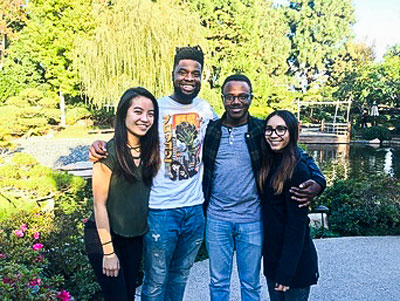Three student-led teams among finalists in Biomimicry Challenge

The three student-designed projects were Rice Age, Limonene Pods and H2U. This is the second consecutive year Cal State Long Beach has had three teams in the finalist round.
The contest, partnered with the Ray C. Anderson Foundation, invites university students and professionals to address critical sustainability issues with nature-inspired solutions. This year’s theme focused on climate change.
“When it comes to climate change, most people are aware of the issues with transportation, waste and deforestation,” said Dominique Gan, leader of the Rice Age team. “However, upon our research, we discovered multiple problems wit the rice industry, such as the consumption of plastic, the loss of water and emission of methane.”
Gan and his three fellow team members – all undergraduate industrial design majors -- used this finding to design Rice Age, a “hexagrain” rice tray that will maximize the land by allowing Japanese farmers to plant more rice with the same amount of land space. It also will reduce methane-producing microbes by oxygenating the soil, and preserve water by retaining more of it.
Their innovative idea earned them second place and a $1,500 prize in the overall judging. They, and the other 10 finalists are eligible compete for a spot in the Biomimicry Launchpad program and for the $100,000 Ray of Hope Prize.
“It was a very long a tiring process and there definitely were a few tears, but we were proud as a team,” Gan said. “It definitely wasn’t easy for us since our initial concept didn’t receive the best feedback.”
Gan said the rough start inspired the Rice Age team to work harder, adding that “the initial failure was necessary since if it was for that, we wouldn’t have developed the concept that landed us in second place.”
Limonene Pods is designed to break down hydrophobic wax that can be found in soil following wildfires, allowing ground to absorb more water during rainfall and lessen the severity of debris runoff and mudslides.
Triggered by last year’s devastating mudslides in Montecito, California, the Limonene Pods team investigated how seeds disperse, plant and root themselves, along with how a dwarf frog’s bubble nest dissolves to build winged pods of soybean bioplastic that biodegrade and provide protection and enrichment of the soil lost in fire.
“With the effects of climate change, the fires are becoming larger and more frequent, and the rains are becoming heavier and lasting longer,” team leader Delaney Santos said. “These effects will likely lead to an influx of deadly debris flow.”
H2U also worked to improve water based on the design of a spider’s web, duck paddle and narrow-leafed plants. With a net, fan and water tank, the team’s design enables rapid water collection from fog. The fog naturally condenses into water on the net system and will drop down into a tank. The team of undergraduate industrial design majors utilized a fan to maximize the efficiency of collecting water.
“The most exciting feature of H2U is that the net is made of plastic bottles, thus H2U partly helps solve the current plastic waste crisis,” said H2U team leader Vin Duy Hua.





